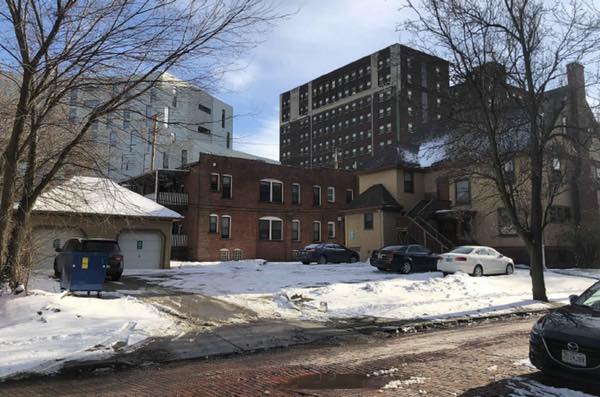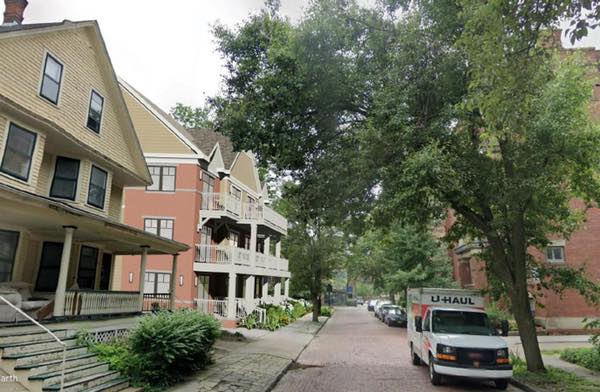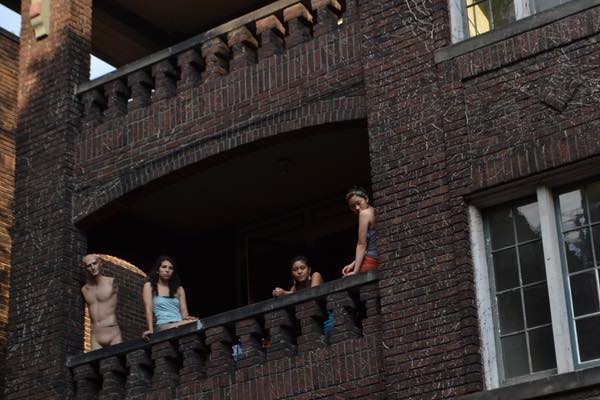
On February 10, University Circle Incorporated (UCI) hosted a virtual “public” meeting announcing a new development project coming to Hessler Road and Ford Drive, in Cleveland’s first historic district, the Hessler Court and Hessler Road Historic District.
At that time, the project included construction of a four-story 23 micro-unit apartment building on Hessler Road, now proposed as a three-story 12 micro-unit apartment building in the backyard of 1975 Ford Drive. The new micro-unit building is proposed to be shoehorned in between 1975 Ford Drive and 11302 Hessler, both two-story wood-frame houses. The project also includes renovations of 1981 and 1975 Ford Drive, seemingly for the purpose of increasing the occupancy and hiking the rents, rather than rehabilitation of the buildings.
The proposed development will be the first new construction in the tiny, completely intact historic district, which is made of up a narrow tree-lined one-way, red brick road and an even narrower one-way woodblock egress called Hessler Court. The historic district has long been home to a community of long-term residents, property owners and students who care for the district, work to keep housing affordable and host the annual Hessler Street Fair.

University Circle Incorporated (UCI) left the Hessler community out of the planning process and presented the project as a “done deal” on February 10th. The community was told groundbreaking could start as early as spring.
In addition to the last-minute informing of the community and a sense of urgency that UCI and the developers created, they also used a variety of deceptive tactics in promoting the project.
A former resident of Hessler Road commented on one such tactic, saying, “The historic home at 1975 Ford Drive has a two-car garage on its single parcel of land. It is unconscionable that this is being referred to as a home with a “vacant lot” behind it. This deceit is intended to appeal to people familiar with the many vacant lots in Cleveland, the ‘missing teeth’ in a neighborhood. This is a willful calculation that the public will not object to the new development if it is perceived as repurposing a ‘vacant lot’. It is an insult to the city’s elected and non-elected officials that anyone would put forth such a calculated deception.”

Despite known community opposition, UCI transferred the land to the developers Rick Maron (Signet, MRN, Uptown LLC, etc.) and Russell Berusch (Bersuch Development Partners LLC, Hessler 113 Townhomes) on March 3.
The Hessler community, while under pressure and stressed about the threat to their beloved historic district, fought hard for time to organize meetings. The community was barely given time to host one meeting each with Councilman Blaine Griffin, UCI and the developers. The community also invited all parties to walk around Hessler together, in hopes that the inappropriateness of the development would be obvious — jeopardizing the aesthetic and already fragile infrastructure of the district, with its century-old water-sewer lines, fragile stone curbs and sidewalks, sinking brick road and crumbling wood block court, encroaching development and disappearing tree canopy.
“I feel it is very important that everybody who has anything to say about the proposal should visit Hessler and the site to see it all in context,” says Laura Cyrocki, president of the Hessler Housing Cooperative and a leader of the Hessler Coalition, a group fighting to save the integrity of the historic district. “You may have been here before but being on Hessler with the new development proposal in mind is telling. You will see how out of proportion in scale and mass the proposal is. You will experience the wear and tear on the district we’ve already faced — a result of aging, density, water run-off, construction impact, negligence by the city and loss of trees,” said Cyrocki.

Eric Ambro is the curator of the Hessler Road Hall of Fame and Museum, located in the historic garage at 1975 Ford Drive during the annual Hessler Street Fair. He is a resident of the street for over 50 years, and says, “It is just the nature of Hessler. You need to come and look at it to really understand it.”
Ambro is heartbroken over the proposed demolition of the garage where for so many years he hosted people from Cleveland neighborhoods and locations around the globe who came to learn more about Hessler Road and its colorful history during the Hessler Street Fair.
Writing on behalf of the Hessler Coalition to the Landmarks Commission, historic preservationist and architectural historian Jessica Wobig addressed concerns about the lack of due diligence by the City of Cleveland and University Circle Incorporated.
Wobig said, “The new construction does not appear to have undergone sufficient planning studies that address historic preservation, nor does the proposed transfer of the property appear to have undergone sufficient public engagement. The consideration of the architectural treatment of the new construction alone does not address all historic preservation concerns, such as historic significance, setting and landscape. Given that UCI is a nonprofit, it is also concerning that a publicly funded organization would have transferred property held since 1974 to a private developer presumably without any preservation covenant or easement in place for the land.”

At the meeting with the developers hosted by the community, members of the community attending felt any discussion of the appropriateness of the development was thwarted. They found they could comment on the details of the design, but comments on the overall impact of the development on the historic district were not accepted by the developers nor by City Council Representative Blaine Griffin. Community members felt they were being used so the developers could check a box that said they had met with the community.
Requests to do site assessment studies before developing the 1975 Ford Drive backyard and suggestions to build a home that fits within the architectural character and residential style of the district were ignored and the developers came back to the community with a scaled-down proposal: a 12 micro-unit apartment that looks like a Motel 6. Also, Maron, under the auspices of “getting community feedback,” abandoned the plan to pave a large area behind three houses on land that he previously clear-cut and excavated for the building of Uptown II in 2012. He was supposed to have installed a landscape screen on that land to provide a buffer for the homes on the south side of Hessler Road. Maron never installed the landscape screening, and the City of Cleveland never enforced its ordinance requiring the screening be installed.

Threats of demolition and development are nothing new to the Hessler community. The community has a rich history of community organizing. In fact, Cleveland’s Landmarks Commission originated in 1971 out of the work done to protect Hessler by Hessler community members, including Case Western Reserve University architecture students, and a dedicated Hessler-ite: Donna Lee “Pitter” Pratt.
In 1974 they worked to get Hessler Court, the last remaining woodblock-paved road in Cleveland, listed on the National Register of Historic Places. In 1975, they organized at City Hall to designate Cleveland’s first Historic District: The Hessler Court and Hessler Road Historic District.
Residents also organized a rent strike against negligent landlords in the University Circle neighborhood. Negotiations with one of the landlords, University Circle Incorporated, led to residents purchasing two double houses and three row houses, forming the non-equity Hessler Housing Cooperative in 1979.
For Hessler Housing Cooperative member Chuck Hoven, the failure of UCI to live up to commitments it made when its Director of Development Ken McGovern participated in creating the Hessler Road Plan in the late 1970s, is an affront to those whose past sacrifices have contributed to creating a unique culture on Hessler Road. Hoven sees the document as very much part of the legacy of Hessler Road. The document spells out the activism of those, like his late wife Margie Bray, who worked to make Hessler Road special. Norm Krumholz, the City of Cleveland Planning Director at the time the document was written, saw the Hessler Road Plan as a model that the many community organizers, who lived in the University Circle neighborhood at the time, could export to other neighborhoods in Cleveland: a model that could be used in the future to protect neighborhoods from the ravages of gentrification.

Now is such a time when the Hessler Road Area Plan should be used. However, UCI insists it has no obligation to follow the plan.
Hoven says, “This is totally disrespectful to those who spent years of their lives putting together the plan. It hurts those of us who knew Norm Krumholz and respected him as the father of equity planning in the United States. This plan is not only part of Norm’s legacy, but also part of the fabric of the Hessler Court and Hessler Road Historic District. The failure of UCI to offer first right of refusal for its properties on Ford to tenants or to the Hessler Housing Cooperative prior to selling them to a developer, as required by this anti-gentrification agreement between residents, UCI, City Planning and the Landmarks Commission, is an affront to that legacy.”
Students in the neighborhood have said they would like to see the rents kept affordable on Ford Drive and Hessler Road. The Observer, the Case Western Reserve University student newspaper, wrote a strong editorial titled “Gentrification in University Circle” concerning the escalating cost of housing in the neighborhood. Students in Berusch’s Hessler 113 Townhomes are paying the highest rent at close to $1,000 per month to rent a bedroom. If this trend is allowed to continue, many students will be priced off of Hessler, or strapped with thousands of dollars in debt for housing alone when they graduate. The development proposal includes renovating 1975 and 1981 Ford Drive, which will displace tenants there due to rent more than doubling. Berusch will increase the number of bedrooms in 1981 Ford and rent each bedroom for around $900 per month. Each roughly 500 square foot micro-unit will rent for $1600/month. The proposal also calls for the expectation that tenants will cough up an additional $130 a month to park in the UCI garage across the street.

The proposed micro-unit will add a completely new concept in rental housing not found within the district and appears more like a hotel in its design and use. Increased use of the rent-by-the-room model also contributes to a hotel-like feel to the district and diminishes the opportunity for long-term residents to stay on Hessler. There is a fine balance on Hessler between long-term owner-occupants, long-term tenants and students, which has allowed Hessler to create a community that has cared well for the street since at least the 1940s.
Even earlier evidence of Hessler’s culture of community is found in an article on the Cleveland Heights Historical Society website, about the Fairhill Road Village Historic District (1929), which was a planned location for “people with kindred tastes, including artists, interior decorators, architects, musicians and writers to live together.
In the past two months since UCI revealed their plans for the development, the rights and concerns of those who live or own property in the Hessler Court and Hessler Road Historic District have been routinely ignored. Numerous emails to city officials have gone unanswered. Public participation in meetings has been blocked, while UCI, the developers and the councilman have been given ample space to express their views. Demands for proper assessments of the Historic District for the suitability of the proposed development have been denied. Councilman Blaine Griffin announced that he is getting funds to help repair the district, but so far has only pulled together $108,000 and has given few details about the scope of the repairs.
The Hessler Coalition formed to try to fight the silencing of the community and spread the word about the threat to this beloved historic district. In an outpouring of support, Hessler Coalition allies rallied to the Hessler’s defense. At its April 22nd meeting on the proposal, the Cleveland Landmarks Commission reported receiving 60 letters against the proposed development project and only two letters in support of the development proposal.

Hessler Coalition supporters are urged to keep the letters flowing to the City of Cleveland. The proposal will be reviewed by the Euclid Corridor Design Review Committee Thursday, May 6th where UCI, Maron and Berusch will seek schematic approval. If they get schematic approval from Design Review, they will seek final approval from the Landmarks Commission on May 13th.
The Hessler Coalition hopes that the Landmarks Commission members will have the courage to stand up to those pushing this project forward and vote against the proposal, saying it will create a permanent and detrimental change to the character of the Hessler Court and Hessler Road Historic district and the community that’s stewarded it for decades.
The district is a completely intact historic district with no new construction within its boundaries. While the 1975 Ford Drive garage or “auto house” is not a high-style building, it and the open backyard tell a story of the 1975 Ford Drive home at a time when open space and automobiles were important to residential development in Cleveland.

If developed, the story of that space and its relationship to the whole historic district will be lost. It has been a space cherished by the community and it is integral to the success of the Hessler Street Fair. The Hessler Street Fair became a tradition to draw vigilance and foster a sense of care for the street, constantly under threat of demolition, development and gentrification. The Hessler Coalition hopes the developers will withdraw their proposal so that UCI and the community can engage in the type of inclusive and perhaps “equity based” community planning that should have happened in the first place.
For more information on the efforts of Hessler Road residents to continue this battle against inappropriate development in the Hessler Court and Hessler Road Historic District and to take action to assist them, visit the Hessler Coalition website at www.hesslerstreet.wordpress.com
[Submitted by the Hessler Coalition]
4 Responses to “Hessler Road Residents & Property Owners Weigh In on Proposed Development”
Laura Cyrocki
Thank you CoolCleveland for creating a space for our voices to be heard!
Sincerely,
The Hessler Coalition
Walter Bruckner
Hessler Street died when Case wrecked Bellflower back in the day. Then they built Uptown, but what did you want? A gravel parking lot on that corner forever? And people are complaining about density? Isn’t it a city? And cheap rents? Well there’s a whole mess of cheap rents just north of Wade Park. Golly, I wonder why Case students don’t move there? Anyone got an idea why? The whole damn thing sounds like we are once again fronting White Boy problems to the exclusion of all else.
Andrea Schmidt
As a resident of Hessler for over 40 years and one of the original signers of the Hessler Housing Coop I would like to comment and attest to the veracity of this report. I UCI should have it’s 501 c3 tax status revoked. It has not kept the promises it has made to the community. It has
Peanuts
Same bullshit the Hessler residents have been fighting for going on 60 years. May they win this round, too.